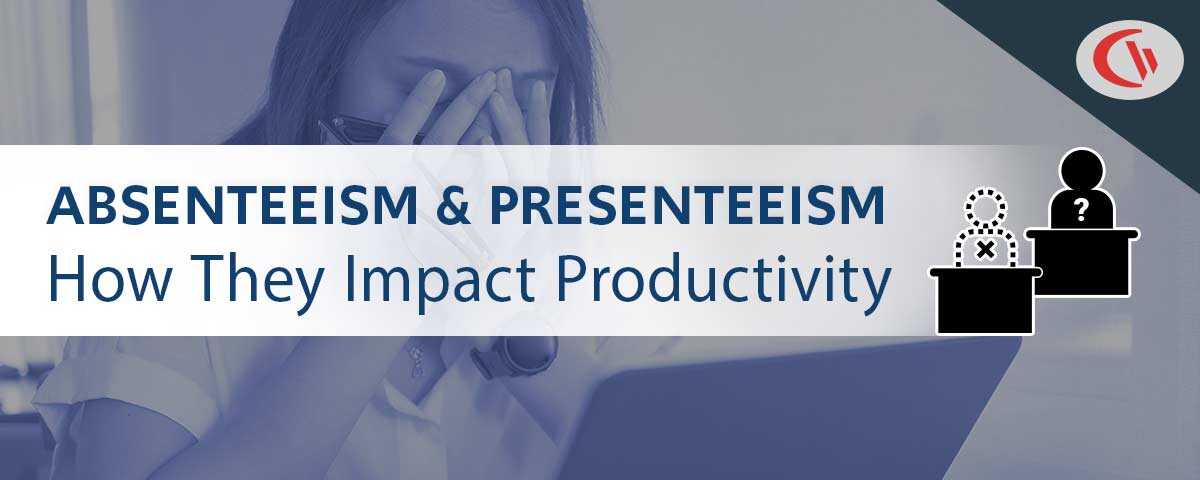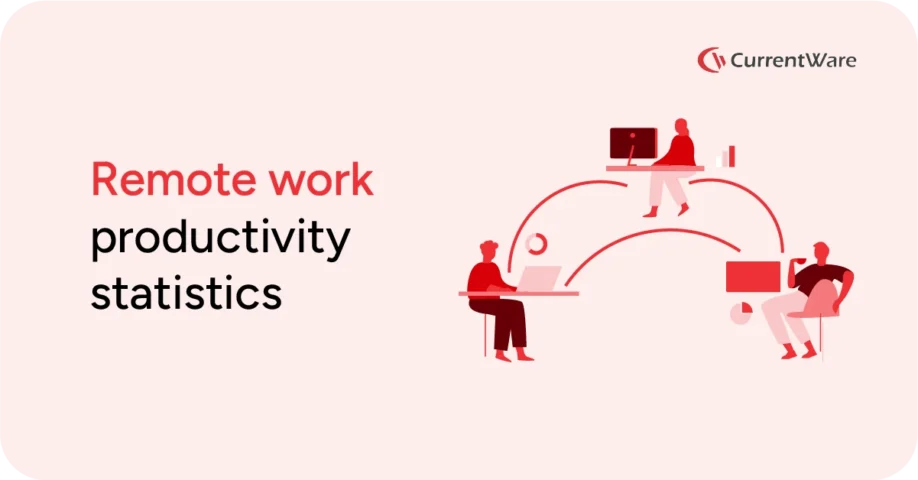How Absenteeism and Presenteeism Affect Productivity

Absenteeism—being absent from work without a valid reason—is a chronic problem for U.S. employers, conservatively costing $3,600 per hourly employee per year, and $2,650 per salaried employee per year. Based on this, a company of 5,000 hourly employees will lose over $18 million per year without a strong absence policy.
But being physically present isn’t always the best thing for overall productivity. Presenteeism, where employees work while sick or injured, also reduces productivity and efficiency, costing U.S. employers $150 billion annually.
Organizations can significantly reduce costs and improve workplace performance by addressing absenteeism and presenteeism effectively. This article will compare and contrast these phenomena while providing tips for managing both as an employer.
Detect Absenteeism and Presenteeism With CurrentWare
CurrentWare helps you track productivity, confirm active working hours, detect excessive idle time, and optimize workforce performance with accurate insights. Get to know who’s truly working—and who’s just clocking in!
- Spot Hidden Absences: Easily identify employees logging time without active engagement to reduce absenteeism disguised as work
- Monitor Real-Time Productivity: Track employee activity to ensure on-the-clock hours are actually productive
- Reduce Presenteeism Costs: Flag abnormally low productivity rates from employees who are physically present but mentally disengaged, helping you detect presenteeism before it flourishes
- Support Remote & Hybrid Teams: Get a clear view of remote employee attendance and productivity to support flexible work models effectively
What Is Absenteeism and Presenteeism?
Absenteeism and presenteeism are two sides of the same coin regarding employee attendance and productivity.
- Absenteeism occurs when employees frequently miss work, often without valid reasons. While occasional absences due to illness or personal emergencies are understandable, habitual absenteeism against an established employee attendance policy can disrupt workflows, overburden coworkers, and negatively impact overall productivity.
- Presenteeism is when employees show up to work despite being unwell. It might seem like dedication, but working while sick or burned out can lead to lower productivity, costly mistakes, and even the spread of illness to coworkers.
Both absenteeism and presenteeism impact businesses negatively, though presenteeism is often harder to spot. Companies can improve productivity and reduce their negative impact by understanding and addressing these two issues.
The Impact of Absenteeism and Presenteeism on Productivity
Absenteeism reduces productivity by increasing the workload on others and causing task delays due to missing employees. Presenteeism, when employees work while unwell, affects productivity by reducing performance, spreading illnesses, and increasing the likelihood of errors.
Both absenteeism and presenteeism lead to decreased overall efficiency and higher costs for organizations. Because presenteeism is harder to detect, its long-term impact often goes unnoticed until performance issues accumulate.
Absenteeism Statistics
- Unscheduled absenteeism costs roughly $3,600 per year for each hourly worker. Additionally, it also costs roughly $2,650 each year for salaried employees.
- Research by the European Foundation for the Improvement of Living and Working Conditions estimated that the cost of absenteeism in the workplace could reach around 2.5% of GDP in Europe. This would add up to a total cost of absenteeism of $470 billion in the European Union alone
- Two-thirds of absenteeism is caused by circumstances other than employee wellbeing, such as family emergencies
Presenteeism Statistics
- Presenteeism costs U.S. companies over $150 billion a year in 2004
- Before the pandemic, data from one UK survey showed that 80% of workers said presenteeism existed in their workplace, with a quarter of the respondents saying it had got worse since the prior year.
- In 2015 the CDC reported that overall worker illness and injury costs U.S. employers $225.8 billion annually
What Causes Absenteeism and Presenteeism?
In order to reduce presenteeism rates, you need to explore this question further—Why do employees choose to go work when they don’t feel well?
Presenteeism occurs not only when employees are present at work despite serious communicable diseases, it also includes working while under the influence of allergies, mental health issues, asthma, and other chronic health conditions.
Presenteeism can have a more significant impact on productivity than absenteeism because employees show up but operate at diminished capacity. Mental health issues like anxiety and burnout are major contributors, particularly in hybrid or high-pressure work environments. Moreover, economic uncertainty and job insecurity further exacerbate the issue, with workers more inclined to remain present even when unwell to demonstrate their commitment and job value.
Without intervention, presenteeism can lead to burnout, negatively impacting both individual well-being and long-term business performance. Addressing presenteeism requires proactive measures such as mental health support, clearer sick leave policies, paid sick days, and workplace flexibility to encourage recovery without penalty.
As for absenteeism; it can be caused by a variety of factors, including:
- Health issues: This includes both physical and mental health problems.
- Work-related stress: Heavy workloads, poor working conditions, and job dissatisfaction can lead to stress and burnout, which can in turn lead to absenteeism.
- Family issues: Childcare responsibilities, eldercare, and other family obligations can sometimes make it difficult to get to work.
- Personal issues: Financial problems, relationship difficulties, and other personal issues can also contribute to absenteeism.
- Job dissatisfaction: Employees who are unhappy with their jobs may be more likely to call in sick or take time off.
- Workplace culture: A negative or toxic workplace culture can also lead to absenteeism.
It is important to note that these are just some of the possible causes of absenteeism. The specific reasons for absenteeism will vary from person to person.
Unfortunately, absenteeism and presenteeism are closely linked. Being too heavy-handed with either is likely to result in shifts in the other. For example, implementing a strict attendance policy may incentivize employees to prioritize physical presence over their wellbeing.
Presenteeism Case Study
This example of presenteeism comes from a Harvard Business Review report from Paul Hemp called “Presenteeism: At Work—But Out of It”
“For years, Amy Farler, who designs transmission components for International Truck and Engine, suffered in silence. Once in a while, when an allergy-related sinus headache escalated into a full-blown migraine, she missed a day of work. But most of the time, she went to the office and quietly lived with the congestion and discomfort of her seasonal allergies. “Sometimes, it’s like you wouldn’t mind if your head rolled off your body,” says the 31- year-old engineer, who spends most of her day working with 3-D models on a computer screen. ‘You feel clogged up and hazy. The pressure makes you want to close your eyes. It’s hard to focus. You end up just muddling through.’
However, a handful of companies—including International Truck and Engine, Bank One (recently acquired by JPMorgan Chase), Lockheed Martin, and Comerica—are recognizing the problem of presenteeism and trying to do something about it. That entails determining the prevalence of illnesses and medical problems that undermine job performance in the workforce, calculating the related productivity loss, and combating that loss in cost-effective ways.
For example, International Truck and Engine, as part of a study of how allergies affect the company’s workforce, offered interested employees free consultations with an allergy specialist at its truck development and technology center in Fort Wayne, Indiana, where Amy Farler works. After her meeting, Farler decided to get a complete evaluation from another allergist, who ultimately determined that she had in the past been misdiagnosed: She was allergic not only to seasonal ragweed pollen but also to dust mites, which was why her symptoms persisted throughout the year. The doctor prescribed a combination of drugs that significantly improved her condition. Although she still has some problems during peak hay fever season, most of the time she feels pretty good. ‘I’m definitely a lot more alert and able to concentrate better’ says Farler, who estimates that her productivity may have suffered by as much as 25% before she was correctly diagnosed.”
Solutions for Mitigating Absenteeism and Presenteeism
1. Flexible Work Arrangements
When employees have the choice to work from home or adjust their schedules to accommodate their needs, they’re more likely to take the time they need to recover or refocus, thus improving their productivity when they do work. This shift can help reduce health-related issues and prevent burnout, which leads to better work quality and engagement.
- Research suggests that monthly attendance records improve when corporate policies promote good work-life balance, offer flexible working arrangements, and allow extra time off on an as-needed basis.
- Half of the remote employees interviewed for Indeed’s Remote Work Survey said that working from home helped reduce their sick days. According to the survey, 56% said it reduced their absences overall.
- 30% of respondents in a survey by the International Data Corporation (IDC) expect reduced absenteeism after allowing a portion of the workforce to primarily work from home. This is further confirmed by another IDC survey that found that 48% of respondents in North America working from home reported higher productivity, while 58% reported reduced absenteeism
2. Health and Wellness Programs
According to a Deloitte report, while 39% of the employees surveyed stated that work had affected their mental health over the past 12 months, not every employee is eager to share their personal life. Iin fact, only 49% of the UK employees surveyed felt comfortable talking to their line manager about their mental health.
That said, managers still play a role in supporting the work-life balance of workers by making sure they feel supported enough to take time-off if they aren’t going to be able to do their jobs well.
Health and wellness initiatives include:
- Fitness Programs: Offering gym memberships, on-site fitness classes, or fitness challenges to encourage physical activity.
- Mental Health Support: Providing access to mental health resources, such as counseling services, stress management workshops, and mental health days.
- Nutritional Counseling: Offering nutritional advice, healthy eating workshops, and access to healthy snacks in the workplace.
- Wellness Challenges: Organizing wellness challenges that promote healthy behaviors, such as walking challenges or hydration challenges.
- Ergonomic Workspaces: Ensuring that workspaces are ergonomically designed to prevent injuries and promote comfort.
While it’s ultimately an employee’s responsibility to manage their health and wellness, companies can greatly help alleviate circumstances within their workforce with genuine support and understanding that is reflected in its policies and practices.
3. Detect Presenteeism and Absenteeism Before It’s Too Late
It’s time to take a deeper look at presenteeism and absenteeism within your own office and teams. Without insights into employee work patterns, the impacts of presenteeism and absenteeism may not be noticed until it’s progressed significantly.
CurrentWare’s office attendance tracking software captures data on login times, session durations, and general computer activity. By analyzing these patterns, employers can identify trends like frequent late arrivals, early departures, or gaps in daily login activity that may indicate absenteeism.
For example, if an employee consistently logs in late or has extended breaks throughout the day, these patterns may be signs of disengagement or personal challenges that can lead to chronic absenteeism. CurrentWare’s monitoring tools provide this employee engagement information in the form of comprehensive reports, logs, and dashboards, allowing managers to identify trends early and have discussions with affected employees.
Monitoring tools also play a role in detecting presenteeism. For example, if a normally productive employee shows a sudden drop in productivity or begins working erratic hours, it may indicate they are present but not fully engaged, or even working late to make up for lost productivity.
By analyzing metrics such as time spent on work-related versus non-work activities, working anomalous hours, and not taking adequate breaks, managers can detect when employees are struggling with presenteeism before it leads to burnout.
4. Company Culture & Work-Life Balance
Company culture and work-life balance have a profound impact on reducing both absenteeism and presenteeism, as they contribute to employee satisfaction, well-being, and engagement.
Presenteeism thrives in overwork cultures that prioritize attendance over outcomes. Without full organizational buy-in to support employees in taking time off when needed, presenteeism and absenteeism will flourish.
A supportive company culture fosters an environment where employees feel valued, supported, and motivated to contribute actively. Companies with positive cultures often promote open communication, encourage employee recognition, and set realistic expectations, which reduces stress and burnout. When employees feel they are part of a company that values their well-being, they are less likely to engage in absenteeism, as they see themselves as an integral part of the team.
For example, cultures emphasizing mutual respect and inclusivity encourage employees to communicate openly about their needs and challenges. This environment enables managers to detect potential signs of presenteeism (such as employees coming to work when unwell) and absenteeism earlier, allowing for timely interventions.
Detect Absenteeism and Presenteeism With CurrentWare
CurrentWare helps you track productivity, confirm active working hours, detect excessive idle time, and optimize workforce performance with accurate insights. Get to know who’s truly working—and who’s just clocking in!
- Spot Hidden Absences: Easily identify employees logging time without active engagement to reduce absenteeism disguised as work
- Monitor Real-Time Productivity: Track employee activity to ensure on-the-clock hours are actually productive
- Reduce Presenteeism Costs: Flag abnormally low productivity rates from employees who are physically present but mentally disengaged, helping you detect presenteeism before it flourishes
- Support Remote & Hybrid Teams: Get a clear view of remote employee attendance and productivity to support flexible work models effectively
More Resources
Detecting, preventing, and managing presenteeism and absenteeism is a formidable challenge for businesses. Check out these complementary resources to learn more about improving employee productivity and engagement.


